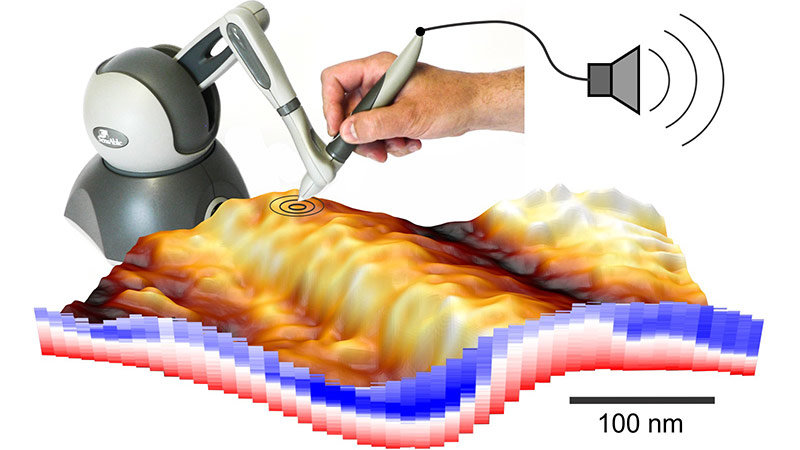English version Deutsche Fassung
Seeing, Hearing, and Feeling in the Nanoworld
Nanomechanical tissue properties will be made accessible to the human senses. This research idea combining physics and cognitive science is funded by the Volkswagen Foundation.
-

Schematic illustration of the proposed multisensory interface. The example shows atomic force microscopy data for force vs. distance, measured on collagen fibrils within a thin section of sheep tendon (photo/graphics: Robert Magerle).
With an atomic force microscope, the shape of a surface and its local mechanical properties can be measured in great detail on the nanometer scale. Understanding this complex and multidimensional data, however, is still in its infancy. Biological tissues in particular display a very complex spatial structure, and their mechanical properties remain largely unexplored on the nanometer scale. The same holds for individual atoms and molecules deposited on surfaces and the forces acting between them. In the case of such complex data, analytical methods based on statistical data reduction have reached their limits.
Prof. Robert Magerle (Chemical Physics) and Prof. Alexandra Bendixen (Cognitive Systems) at Chemnitz University of Technology would like to fundamentally change the access to data analysis by making complex data accessible to human perception and cognition. With a haptic interface, the force fields measured with an atomic force microscope will be translated into forces perceivable to humans. Simultaneously, the surface shape and its local mechanical properties will be visually and acoustically presented. This will allow human users to interactively explore the forces measured on the nanometer scale, while simultaneously employing multiple senses. Such a type of data display appears particularly suitable for discovering so far unknown structures in spatially complex data with the help of human perception and cognition. In the project, we will examine different types of force translation functions with the haptic display, and we will study the interplay of human senses in the perception of the nanomechanical properties of biological tissues. The Volkswagen Foundation is funding the project with 120,000 euros for 18 months through its funding initiative "Experiment!".
The Project in Detail
Why should it be worthwhile to use the human senses to explore nanomechanical properties and forces on the nanometer scale? From sensory and cognitive psychology, it is well known that humans are remarkably adept at discovering patterns within complex structures as well as deviations from these patterns. If we succeed in using this human ability for biophysical research topics – in this project, for exploring nanomechanical tissue properties – this would offer the opportunity to discover entirely new physical phenomena. The project's cognitive science component complements the modern measurement methodology of atomic force microscopy by adding a novel analysis strategy. To ensure that this approach is successful, a number of scientific and technical challenges need to be mastered. Our goal is creating an interface that allows humans to explore the spatially complex data of nanomechanical force fields interactively and with multiple senses simultaneously (visual, auditory, and haptic). From a technological viewpoint, the multisensory display has to translate the user's hand motion fluently and quasi in real time into a haptic, visual, and auditory presentation of the data. Avoiding a perceivable delay between the different display channels is essential, since humans are very sensitive to asynchronies between the senses and to delays between perception and action. Of equally high importance as the technical challenge is the question of how particular nanomechanical properties – such as the specimen's viscoelasticity – can be translated to the human senses and represented so that they can be efficiently explored. This will require combining insights from cognitive science about the design of multisensory displays with detailed physical knowledge about nanomechanical properties. In combining these two fields, the project aims to break new ground. Within the next 18 months, we will test which advances in exploring nanomechanical properties can be achieved.
Research in Sensing and Cognition
At the heart of the project funded by the Volkswagen Foundation is understanding human sensory and cognitive processes, which in turn will enable complex physical data to be displayed to human users in a more favorable way. The project is part of the new research focus on "sensing and cognition" at the Faculty of Natural Sciences, which combines the fields of physics and psychology. This focus area comprises the Centre for Sensing and Cognition and the BSc and MSc degree courses in Sensory and Cognitive Psychology, covering the fundamental topics in cognitive psychology, physics, and related fields.
The Funding Initiative "Experiment!"
The Volkswagen Foundation's funding initiative "Experiment!" addresses researchers in the natural sciences, engineering, and the life sciences who plan to test a fundamentally novel and risky research idea. At the same time, the foundation is testing a completely new review process. In 2017, the foundation pre-selected 119 from all 594 proposals received. An external selection committee of eight scientists from abroad evaluated only these anonymized ideas, screened for qualitatively convincing proposals, and selected 17 of them for funding. Additionally, projects from all convincing proposals were drawn in a lottery. In this way, ideas that might otherwise easily be overlooked get a chance, with 29 projects receiving new funding.
Contact
For further information about this project, please contact Prof. Robert Magerle, E-mail robert.magerle@…, Telephone +49 371 531-38033 or Prof. Alexandra Bendixen, E-mail alexandra.bendixen@…, Telephone +49 371 531-31681.
(Authors: Prof. Robert Magerle and Prof. Alexandra Bendixen. This text is the expanded English version of an article published in Uni aktuell on November 16, 2017.)
